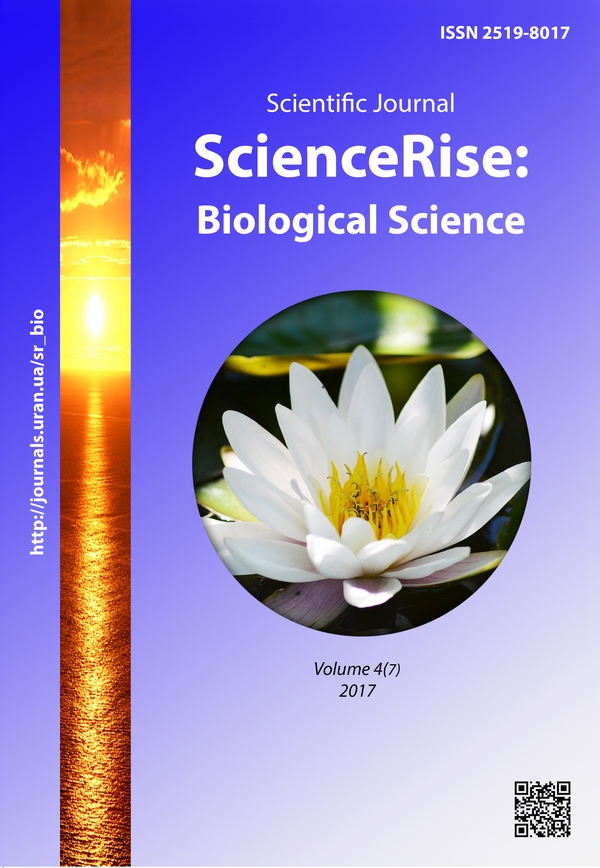Іnvestigations of the dust air pollution in the production of poultry
DOI:
https://doi.org/10.15587/2519-8025.2017.109220Keywords:
dust pollution, industrial poultry farming, atmospheric air, bioindication, Betula pendulaAbstract
Aim of research – to determine the dust concentration in production accommodations and beyond poultry yards in the sanitary-protecting zone of a poultry enterprise.
Materials and methods. The research was carried out in zones of location of poultry enterprises of broiler and eggs production. Poultry enterprises are located in Kyiv region in different soil-climatic conditions. The analysis of the content of dust in atmospheric air is realized using aspiration methods. The disperse analysis of dust is established by microscopy methods using a microscope MBI -15. The leaf plate dustiness is established by the bioindication method.
Results of researches and their discussion. The results of realized studies testify that the ratio of dust particles of different sizes is different depending on a technology. For example, at keeping poultry at a poultry yard 75 % is fine-dispersed particles less than 5 microns. In feed processing buildings the share of fine-dispersed particles is more (85 %). It was demonstrated that the intensity of the poultry yards working zone air pollution is very high depending on a keeping technology, poultry age, production process. The maximal value of hygienic norms exceed (in 700 tomes) was observed in a feed processing building at forages mixing.
The method of bioindication using Betula pendula Roth phyto-indicator determined the dust concentration on Betula pendula Rot leaf plate surface. It was demonstrated that the dust pollution is observed also beyond poultry yards, at the distance 2m from discharge sources it exceeds the value in the control variant almost 250 times at keeping the parents’ livestock. The concentration decreases with the distance increase.
Conclusion. It was determined that the quantitative composition of different dust fractions is different. To improve the ecological state of atmospheric air it is necessary to observe veterinary-sanitary norms to provide a microclimate and ventilation. The received results give grounds to state that MAC of working zone air pollution can reach 700 times. BetulapendulaRoth was probated and offered to the use as phyto-indicators of the ecological state of territories of the intense poultry farming
References
- Lonс, E., Plewa, K. (2010). Microbiological Air Contamination in Poultry Houses. Polish Journal of Environmental Studies, 19 (2), 15–19.
- Broucek, J., Cermak, B. (2015). Emission of Harmful Gases from Poultry Farms and Possibilities of Their Reduction. Ekologia, 34 (1), 89–100. doi: 10.1515/eko-2015-0010
- Keivan, M. P., Tertуchna, O. V., Keivan, O. P. (2011). Ecological monitoring of the environment in the areas of location of poultry farming enterprises. Agroecological journal, 94–95.
- Tertychna, O., Bryhas, O., Svaliavchuk, L., Miroshnik, N. (2017). Environmental assessment of the state of atmospheric air in conditions of different technologies of poultry production. ScienceRise: Biological Science, 3 (6), 18–21. doi: 10.15587/2519-8025.2017.105062
- Marchenko, O. A. (2010). Ptahivnitstvo – progresuyuchiy zabrudnyuvach atmosfernogo povitrya. Agroekologichniy zhurnal, 3, 34–38.
- Raven, P., Evert, F., Eichhorn, S. (1986). Sovremennaya botanika. Vol. 2. Moscow: Mir, 344.
- Radomskaia, M. M., Kartash, Yu. H. (2016). Otsiniuvannia rivnia pylovoho zabrudnennia atmosfernoho povitria m. Kyieva. Naukovyi visnyk NLTU, 26.4, 219–224.
- Bakhariev, V. S. (2005). Osoblyvosti formuvannia ekolohichnoi nebezpeky v umovakh pylovoho zabrudnennia atmosfernoho povitria. Biosferno-noosferni idei V. I. Vernadskoho ta ekoloho-ekonomichni problemy rozvytku rehioniv. Kremenchuk: Vyd-vo KDPU, 85–86.
- Klimenko, A. P. (1978). Metodyi i priboryi dlya izmereniya kontsentratsii pyili. Moscow: Khimiya, 208.
- Golosova, I. M. (Ed.) (1980). Sanitarno-gigienicheskie issledovaniya vozduha. Leningrad: Leningr. veterin. in-t., 63.
- Rudenko, S. S., Kostyshyn, S. S., Morozova, T. V. (2008). Zahalna ekolohiia: praktychnyi kurs. P. 1. Chernivtsi: Knyhy–XXI, 308.
Downloads
Published
How to Cite
Issue
Section
License
Copyright (c) 2017 Olga Tertychna, Olena Bryhas, Larysa Svaliavchuk, Nataliia Miroshnik

This work is licensed under a Creative Commons Attribution 4.0 International License.
Our journal abides by the Creative Commons CC BY copyright rights and permissions for open access journals.
Authors, who are published in this journal, agree to the following conditions:
1. The authors reserve the right to authorship of the work and pass the first publication right of this work to the journal under the terms of a Creative Commons CC BY, which allows others to freely distribute the published research with the obligatory reference to the authors of the original work and the first publication of the work in this journal.
2. The authors have the right to conclude separate supplement agreements that relate to non-exclusive work distribution in the form in which it has been published by the journal (for example, to upload the work to the online storage of the journal or publish it as part of a monograph), provided that the reference to the first publication of the work in this journal is included.









